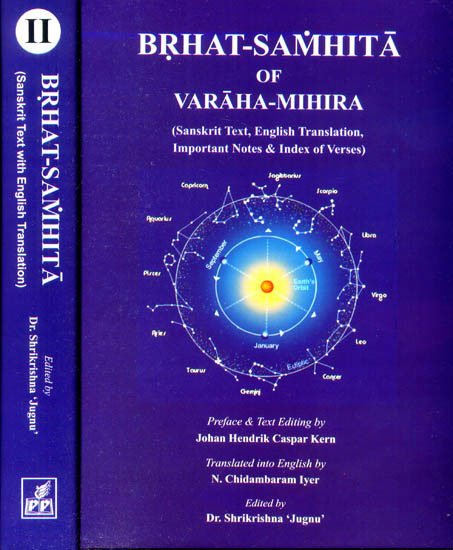Brihat Samhita
by N. Chidambaram Iyer | 1884 | 135,584 words | ISBN-13: 9788171104215
This page describes the features of the elephant (hasti-lakshana) which is the sixty-seventh Chapter of the English translation of the Brihat-samhita. This work, written by Varahamihira in the 6th century, is classified as jyotisha literature, also known as Indian astronomy. It contains however, also content regarding astrology, palmistry, agriculture, gardening, perfumes, medicines and various other encyclopedic topics.
Chapter 67 - On the features of the Elephant (hasti-lakṣaṇa)
[Sanskrit text for this chapter is available]
1. The elephant (hasti) whose tusks are of the colour of honey, whose limbs are will defined, whose body is neither large nor small, and which is capable of bearing heavy burdens, whose limbs are symmetrical, whose back bones are like bows and whose buttocks resemble those of the pig, is known as Bhadra.
2. The elephant whose breast, arm-pits and folds of skin are loose, whose belly is hanging, whose skin and neck are thick, whose abdomen resembles that of the crow, and whose eyes are like those of the lion, is known as Manda.
3. The elephant whose lips, tail and genital organ are short, whose legs, neck, tusks, trunk and the ears are small and whose eyes are large, is known as Mṛga. The elephant (hasti) which possesses the three sets of features above referred to, is known as Saṅkīrna.
4. The Mṛga class of elephants are 5 cubits high, 7 cubits long and 8 cubits broad. The Manda and Bhadra classes are larger by one and two cubits respectively in each respect. No fixed measurement is prescribed for the Saṅkīrṇa class of elephants.
5. The Bhadra is of green colour and is a rutting elephant (hasti). The Manda is of yellow colour. The Mṛga is of black colour and is also a rutting elephant. The Saṅkīrṇa is of mixed colour and a rutting elephant.
6-7. The elephant whose lips and mouth are red, whose eyes resemble those of the sparrow, whose tusks are shining, rising and with sharp end, whose face is large and long, whose back bones are like bows, long and invisible, whose frontal globes (round protuberances on the temples) are covered with hair and resemble the turtle, whose ears, mouth corners, navel, forehead and genital organs are large, whose body resembles the turtle, whose nails are 18 or 20, whose trunk has three lines and is round, whose tail is beautiful, and whose juice (when in rut) is felt to be of good smell when the animal blows through its trunk, will bring on wealth.
8. The elephant (hasti) whose tail is long, trunk red, roar like that of the clouds, and neck large, long and round, will bring wealth to a king.
9-10. Non-rutting elephants, those which possess extra or defective organs, those which are lame or short or whose tusks resemble the horns of the sheep, whose testicles are visible, those which possess little or no trunk, whose mouth corners are brown, blue, black or of different colours, those which possess very little hair about the face, those which have no tusks, those which have no virility, female elephants possessing the features of a male elephant, and pregnant elephants must be sent away to foreign lands. They produce misery.
